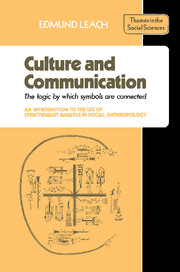 Culture and Communication
Culture and Communication Book contents
- Frontmatter
- Contents
- Culture and communication: the logic by which symbols are connected
- Introduction
- 1 Empiricists and rationalists: economic transactions and acts of communication
- 2 Problems of terminology
- 3 Objects, sense-images, concepts
- 4 Signals and indices
- 5 Transformations
- 6 Theories of magic and sorcery
- 7 The symbolic ordering of a man-made world: boundaries of social space and time
- 8 The material representation of abstract ideas: ritual condensation
- 9 Orchestral performance as a metaphor for ritual sequence
- 10 The physiological basis of sign/symbol sets
- 11 Mapping: time and space as reciprocal representations
- 12 Rank order and orientation
- 13 Examples of binary coding
- 14 Mating prescriptions and proscriptions
- 15 Logic and mytho-logic
- 16 Basic cosmology
- 17 Rites of transition (rites de passage)
- 18 The logic of sacrifice
- 19 Conclusion
- Bibliography
- Index
3 - Objects, sense-images, concepts
Published online by Cambridge University Press: 05 June 2012
- Frontmatter
- Contents
- Culture and communication: the logic by which symbols are connected
- Introduction
- 1 Empiricists and rationalists: economic transactions and acts of communication
- 2 Problems of terminology
- 3 Objects, sense-images, concepts
- 4 Signals and indices
- 5 Transformations
- 6 Theories of magic and sorcery
- 7 The symbolic ordering of a man-made world: boundaries of social space and time
- 8 The material representation of abstract ideas: ritual condensation
- 9 Orchestral performance as a metaphor for ritual sequence
- 10 The physiological basis of sign/symbol sets
- 11 Mapping: time and space as reciprocal representations
- 12 Rank order and orientation
- 13 Examples of binary coding
- 14 Mating prescriptions and proscriptions
- 15 Logic and mytho-logic
- 16 Basic cosmology
- 17 Rites of transition (rites de passage)
- 18 The logic of sacrifice
- 19 Conclusion
- Bibliography
- Index
Summary
A fundamental difficulty in this whole business is that we are concerned all the time with the operations of human minds as well as with objects and actions in the world out-there.
The music which results from the pianist's transformation of notes in the score to finger movements on the keyboard is not a simple consequence of signalled trigger responses. Trigger responses are involved but they are modulated by the musical thought and competence of the performer. And the same applies to the whole range of human communication, both verbal and non-verbal. Whenever we discuss the ‘meaning’ of expressive behaviour we are concerned with the relationship between observable patterns in the world out-there and unobservable patterns ‘in the mind’. But here we come back again to the opposition between rationalism and empiricism. What do we really mean by ‘patterns in the mind’? I would urge you to be sceptical.
Only a very extreme behaviourist psychologist would want to discuss problems of meaning without allowing some degree of ‘reality’ to the operations of mental ideas but the opposite form of distortion is all too common. Much of the theory of signs and symbols (semiology) has been developed by European followers of de Saussure, and they have grappled with the problem of the relationship between ideas and external objects by adopting the extreme rationalist position that we can ignore the external objects altogether.
These writers insist that we need to distinguish carefully between ‘words considered as external objects’- i.e. patterns of sound waves, patterns of marks on paper-and ‘words as sound images’.
- Type
- Chapter
- Information
- Culture and CommunicationThe Logic by which Symbols Are Connected. An Introduction to the Use of Structuralist Analysis in Social Anthropology, pp. 17 - 22Publisher: Cambridge University PressPrint publication year: 1976
- 1
- Cited by


